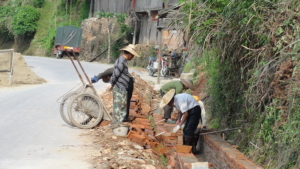Rural Land Engineering in China
 China’s poverty reduction success is exemplary. According to the World Bank, in 2000, China had a poverty rate of 49.8%, which decreased to 0.6% in 2019. But rapid urbanization has led to both land degradation and higher rates of rural poverty. Because sustainable land use is an important part of economic growth, China is attempting to mitigate this rural poverty through the use of rural land engineering.
China’s poverty reduction success is exemplary. According to the World Bank, in 2000, China had a poverty rate of 49.8%, which decreased to 0.6% in 2019. But rapid urbanization has led to both land degradation and higher rates of rural poverty. Because sustainable land use is an important part of economic growth, China is attempting to mitigate this rural poverty through the use of rural land engineering.
According to 2017 data from UNICEF, about 53.6% of China’s rural poor reside in the country’s western region, equaling 16.34 million people. Guizhou holds the highest number of impoverished people at 2.95 million. Xinjiang, an area with high numbers of ethnic minorities such as the marginalized Uyghur people, has the most significant poverty rate — 9.9%.
Since 2000, China has introduced several social development programs in rural communities, such as “universal compulsory education up to grade 9, rural medical cooperative system, social pension system for rural residents and a minimum living allowance scheme,” the World Bank reports.
What is Rural Land Engineering?
Since land degradation is the most significant problem that some rural communities in China face, people are turning to rural land engineering and other similar practices that revitalize the land. In this context, it is a method of agricultural engineering that is able to prevent land degradation. Some forms of land engineering are land consolidation, reclamation, restoration and reallocation. All of these different types of land engineering help curtail land degradation, and therefore, rural poverty.
The most well-known form of rural land engineering is land consolidation. According to the European Environment Agency, land consolidation involves “joining small plots of land together to form larger farms or large fields.” According to an article in Geographical Research, the main objective of land consolidation is to maximize the amount of arable land and advance the conditions of agricultural production. Land consolidation generally consists of practices that seek to maximize the earning potential of a given area.
Why Rural Land Engineering?
To put it simply, this method of curtailing poverty is useful and easy. It creates a balanced man-land system. Because people and land are the two most important parts of rural communities, it makes sense that a balanced man-land system would be optimal for reducing poverty.
Liu Yansui and Wang Yongsheng conducted a study that discusses rural land engineering and how it helps to alleviate poverty. In the study, the researchers find that hilly areas in parts of rural China can be repurposed into productive farmland. This productive farmland would then create income for rural families. By repurposing this hilly land, rural families in such areas can rise out of poverty.
Another key explanation in the study outlines the link between poverty and land engineering. The researchers found that “land engineering utilizes engineering measures to coordinate human-land relationships by transforming unused land into available land or efficiently using the existing land.”
Geographical Research explains that, through the use of land consolidation, impoverished peasants are able to obtain farmland that is supplied with “improved infrastructure and roads.”
A History of Land Engineering
China began land engineering practices as far back as the time of the Xia dynasty but has now moved onto more modern means of land engineering. China established the Key Laboratory of Degraded and Unused Land Consolidation Engineering in 2013.
In 2016, China developed a new commission of the International Geography Union on Agricultural Geography and Land Engineering (IGU-AGLE) in the Institute of Geographic Sciences and Natural Resources Research, Chinese Academy of Sciences. IGU-AGLE focuses on “the improvement in agricultural conditions and consolidation of degraded land and defiled land using land engineering.” Also in 2016, universities in China formalized land engineering as a discipline to “cultivate professional talent for national land technology innovation and development.”
Overall, rural land engineering plays a role in poverty reduction in rural China. China stands as an example of national poverty reduction at a large scale and continues to demonstrate a commitment to dissolving poverty among rural populations.
– Timothy Ginter
Photo: Flickr
